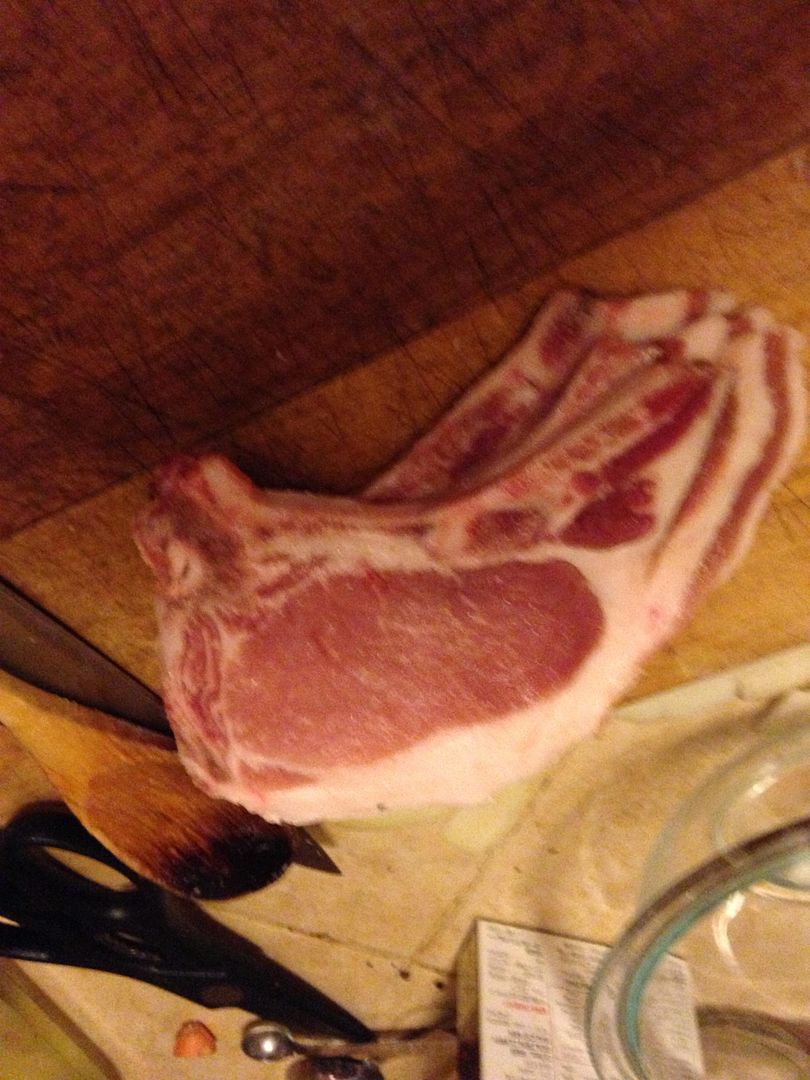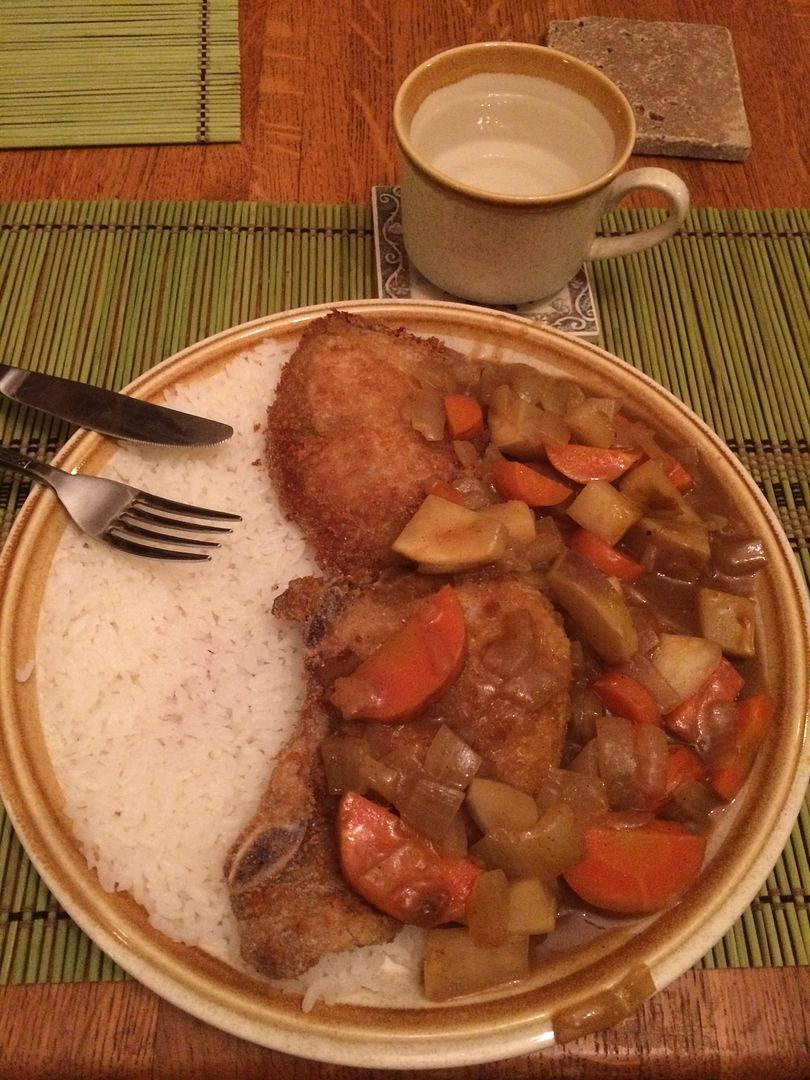Fifty Weeks, Fifty Curries: C-C-C-COMBO BREAKER One: カツカレー
Surprise!
When I worked at Suzugamine, my second-favorite day of the week was Wednesday. My favorite day was Monday, because I only had one class that day and having a free day early in the week made weekly lesson planning really easy, but my second-favorite day was Wednesday because I'd get lunch at school in order to reduce softlykarou's workload. For ¥550, I'd get a heaping plate of カツカレー, with delicious fatty pork, savory sauce, and fluffy rice, and I'd devour the whole thing. I even ate the first couple plates with chopsticks until the cafeteria workers told me in somewhat confused tones that it was okay to use a spoon.
That was what really made me love tonkatsu. I'd never known exactly what was so great about it before then, but that year of school lunches kicked me over into the カツカレーcamp, and I've been trying to find out how to replicate that taste ever since. And with this latest entry, I think softlykarou has figured it out.

No full ingredients picture, but here's the most important ingredient.
Whenever we'd made カツカレー before, or really anything with tonkatsu, the biggest problem was the tenderness. Whenever we'd get it in a restaurant, it'd be mouth-wateringly juicy, with delicious fat along the edges and cut easily under a simple knife. Whenever softlykarou would try to make it herself, it'd always end up tougher, no matter how long she spent scoring it or tenderizing it. She could take thirty minutes and I'd still have to rip into the tonkatsu when it was done frying, and that certainly made it harder to eat since the main part I remembered from restaurant or cafeteria tonkatsu was the tenderness.
This time, it was all there. We bought heritage pork from the local organic hippie co-op and everything turned out exactly like I remembered it. The only problem is that the pork was bone-in and we had to cut around it, but I imagine that leaving the bone in while it was frying let some of the marrow out into the pork, so it probably all turned out for the best. And it wasn't like the lamb we got for the other curries where there were tiny bones everywhere--the bone was in one piece on one side. It tasted delicious.

Sauce isn't quite as important to me in this curry, but it's still up there.
Words from the Chef
I always get nervous when I'm deep frying because, in spite of the fact that it has never even come close to happening, I am afraid of starting a grease fire. It's probably why my deep frying is kept to a minimum in spite of my Southern roots. Anyway, when my husband proposed katsu-curry how could I say no. One thing I'd learned from making tonkatsu in the past is that a lot of pork in America is too lean. I have to really tenderize it and it's often a bit on the dry side. But this time we bought pork from our Hippie Organic Co-op and the chops had a bone in as well as nice marbling with a good layer of side-fat. I also tried frying with avocado oil and liked that a lot. They turned golden brown nicely and were evenly cooked in addition to being delicious and juicy! The meat was tender even when the last one ended up a bit overcooked. Also I learned that through my curry experiences I have learned not to rush, or rather how to slow down and be mindful while cooking. I've also improved my ability to prioritize in the kitchen which is nice. I wouldn't make this all the time, the sodium in the curry mix would kill us, but I would make it once in a while for sure!

I can hear the sizzle as I write this.
The sauce--I have to talk about the sauce--wasn't as good as the pork, though. A proper Japanese curry sauce should fill the mouth with delicious umami flavor from the first bite to the last, and this sauce had a bit of curry heat, but otherwise fell pretty flat. softlykarou included some turnips in the sauce, and they helped a lot in the same way that they did with shalgam gosht, but it wasn't enough to really bring it up to something memorable.
However, softlykarou didn't make the sauce from a recipe, we bought it at the nearby Asian grocery store, so the solution to this problem is obvious. We bought an inferior sauce and need to buy something different. There's a whole shelf of different curry sauces, so we'll just need to test a few and find the one that works out right. Though as softlykarou says, we should do it at a relatively slower pace lest we die of sodium overload.

I got two cutlets because softlykarou loves me that much!
We don't necessarily need to only have the tonkatsu with curry, though. It's pretty common on its own in Japan, with rice on the side, tonkatsu sauce, and a pile of cabbage with either yuzu or ginger dressing on it. Add a bowl of pickles and some miso soup to that and it sounds like a great meal, and now that we know how to make it properly, we can include it more often. Success!
Would I Eat It Again?: Yes! We figured it out!
Do I Prefer It to the Usual Thai Curry?: No. Some of the other curries I've tried have ended up in different mental categories for me, and Japanese curry definitely ends up that way. Under normal circumstances, I wouldn't want it for curry night at all, but I wanted to write about it.
What Would I Change?: Use a different mix for the curry, and maybe include some green vegetables too.
Note: Curry night was yesterday, but so was WFRP night, so I didn't get to write this post until today.
When I worked at Suzugamine, my second-favorite day of the week was Wednesday. My favorite day was Monday, because I only had one class that day and having a free day early in the week made weekly lesson planning really easy, but my second-favorite day was Wednesday because I'd get lunch at school in order to reduce softlykarou's workload. For ¥550, I'd get a heaping plate of カツカレー, with delicious fatty pork, savory sauce, and fluffy rice, and I'd devour the whole thing. I even ate the first couple plates with chopsticks until the cafeteria workers told me in somewhat confused tones that it was okay to use a spoon.
That was what really made me love tonkatsu. I'd never known exactly what was so great about it before then, but that year of school lunches kicked me over into the カツカレーcamp, and I've been trying to find out how to replicate that taste ever since. And with this latest entry, I think softlykarou has figured it out.

No full ingredients picture, but here's the most important ingredient.
Whenever we'd made カツカレー before, or really anything with tonkatsu, the biggest problem was the tenderness. Whenever we'd get it in a restaurant, it'd be mouth-wateringly juicy, with delicious fat along the edges and cut easily under a simple knife. Whenever softlykarou would try to make it herself, it'd always end up tougher, no matter how long she spent scoring it or tenderizing it. She could take thirty minutes and I'd still have to rip into the tonkatsu when it was done frying, and that certainly made it harder to eat since the main part I remembered from restaurant or cafeteria tonkatsu was the tenderness.
This time, it was all there. We bought heritage pork from the local organic hippie co-op and everything turned out exactly like I remembered it. The only problem is that the pork was bone-in and we had to cut around it, but I imagine that leaving the bone in while it was frying let some of the marrow out into the pork, so it probably all turned out for the best. And it wasn't like the lamb we got for the other curries where there were tiny bones everywhere--the bone was in one piece on one side. It tasted delicious.

Sauce isn't quite as important to me in this curry, but it's still up there.
Words from the Chef
I always get nervous when I'm deep frying because, in spite of the fact that it has never even come close to happening, I am afraid of starting a grease fire. It's probably why my deep frying is kept to a minimum in spite of my Southern roots. Anyway, when my husband proposed katsu-curry how could I say no. One thing I'd learned from making tonkatsu in the past is that a lot of pork in America is too lean. I have to really tenderize it and it's often a bit on the dry side. But this time we bought pork from our Hippie Organic Co-op and the chops had a bone in as well as nice marbling with a good layer of side-fat. I also tried frying with avocado oil and liked that a lot. They turned golden brown nicely and were evenly cooked in addition to being delicious and juicy! The meat was tender even when the last one ended up a bit overcooked. Also I learned that through my curry experiences I have learned not to rush, or rather how to slow down and be mindful while cooking. I've also improved my ability to prioritize in the kitchen which is nice. I wouldn't make this all the time, the sodium in the curry mix would kill us, but I would make it once in a while for sure!

I can hear the sizzle as I write this.
The sauce--I have to talk about the sauce--wasn't as good as the pork, though. A proper Japanese curry sauce should fill the mouth with delicious umami flavor from the first bite to the last, and this sauce had a bit of curry heat, but otherwise fell pretty flat. softlykarou included some turnips in the sauce, and they helped a lot in the same way that they did with shalgam gosht, but it wasn't enough to really bring it up to something memorable.
However, softlykarou didn't make the sauce from a recipe, we bought it at the nearby Asian grocery store, so the solution to this problem is obvious. We bought an inferior sauce and need to buy something different. There's a whole shelf of different curry sauces, so we'll just need to test a few and find the one that works out right. Though as softlykarou says, we should do it at a relatively slower pace lest we die of sodium overload.

I got two cutlets because softlykarou loves me that much!

We don't necessarily need to only have the tonkatsu with curry, though. It's pretty common on its own in Japan, with rice on the side, tonkatsu sauce, and a pile of cabbage with either yuzu or ginger dressing on it. Add a bowl of pickles and some miso soup to that and it sounds like a great meal, and now that we know how to make it properly, we can include it more often. Success!
Would I Eat It Again?: Yes! We figured it out!
Do I Prefer It to the Usual Thai Curry?: No. Some of the other curries I've tried have ended up in different mental categories for me, and Japanese curry definitely ends up that way. Under normal circumstances, I wouldn't want it for curry night at all, but I wanted to write about it.
What Would I Change?: Use a different mix for the curry, and maybe include some green vegetables too.
Note: Curry night was yesterday, but so was WFRP night, so I didn't get to write this post until today.